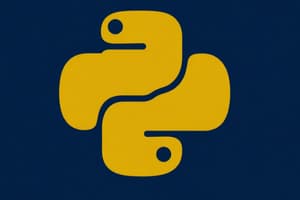Podcast
Questions and Answers
What is the result of comparing 'Amir' > 'Michal'?
What is the result of comparing 'Amir' > 'Michal'?
- True
- False (correct)
- Undefined
- None of the above
'cat' > 'bat' evaluates to False.
'cat' > 'bat' evaluates to False.
False (B)
How does Python compare strings?
How does Python compare strings?
Python compares strings in lexicographical (alphabetical) order.
If strings S and T are compared, and S < T, then there exists some _____ where S and T differ.
If strings S and T are compared, and S < T, then there exists some _____ where S and T differ.
Match the following operations or principles with their descriptions:
Match the following operations or principles with their descriptions:
Which statement is true regarding 'cat' > 'cut' in Python?
Which statement is true regarding 'cat' > 'cut' in Python?
Iterations refer only to loops in programming.
Iterations refer only to loops in programming.
What was young Carl Friedrich Gauss known for in the context of addition?
What was young Carl Friedrich Gauss known for in the context of addition?
What are the Boolean values in Python?
What are the Boolean values in Python?
In Python, the logical operator 'and' returns True if both operands are False.
In Python, the logical operator 'and' returns True if both operands are False.
What is the equivalent of 'not (a or b)' according to De Morgan's rules?
What is the equivalent of 'not (a or b)' according to De Morgan's rules?
The standard logical operators in Python include 'and', 'or', and ______.
The standard logical operators in Python include 'and', 'or', and ______.
Which of the following operators is used for comparison in Python?
Which of the following operators is used for comparison in Python?
The statement 'not b' will return True if b is True.
The statement 'not b' will return True if b is True.
Match the Boolean expressions with their results:
Match the Boolean expressions with their results:
Python's True and False are ______ while in most other programming languages they are not.
Python's True and False are ______ while in most other programming languages they are not.
What is the result of summing the integers from 1 to $n$ using Gauss' method?
What is the result of summing the integers from 1 to $n$ using Gauss' method?
The method based on Gauss' observation requires the same number of addition operations as the iterative summation method.
The method based on Gauss' observation requires the same number of addition operations as the iterative summation method.
How many arithmetic operations does Gauss' method require to calculate the sum of the first $n$ integers?
How many arithmetic operations does Gauss' method require to calculate the sum of the first $n$ integers?
In Python, a list is created by enclosing its elements in __________.
In Python, a list is created by enclosing its elements in __________.
Match the following Python data types with their descriptions:
Match the following Python data types with their descriptions:
Which statement correctly describes the efficiency of the two methods for computing the sum of integers from 1 to $n$?
Which statement correctly describes the efficiency of the two methods for computing the sum of integers from 1 to $n$?
In Python, elements of a list can be accessed via their position or index.
In Python, elements of a list can be accessed via their position or index.
What is the output of 'sum(range(1, 101))' in Python?
What is the output of 'sum(range(1, 101))' in Python?
What will be the result of executing num_list[1:5]?
What will be the result of executing num_list[1:5]?
The expression num_list[8:3:-2] produces an empty list.
The expression num_list[8:3:-2] produces an empty list.
What does num_list[::-1] do?
What does num_list[::-1] do?
The slice num_list[::2] retrieves every ______ element from the list.
The slice num_list[::2] retrieves every ______ element from the list.
What will the output be if the code print(product) is executed after initializing product = 1 and iterating over the list L = [1,2,3,4]?
What will the output be if the code print(product) is executed after initializing product = 1 and iterating over the list L = [1,2,3,4]?
Slicing a list changes the original list.
Slicing a list changes the original list.
Match the following slicing formats with their descriptions:
Match the following slicing formats with their descriptions:
What is the output of len('Rye Bread')?
What is the output of len('Rye Bread')?
What is the output of the list comprehension [n**2 for n in range(1,10) if n%2 == 1]?
What is the output of the list comprehension [n**2 for n in range(1,10) if n%2 == 1]?
In Python, list comprehension can modify the original list without creating a new one.
In Python, list comprehension can modify the original list without creating a new one.
What Python data structure is used to hold a collection of elements?
What Python data structure is used to hold a collection of elements?
Using list comprehension, the expression [st for st in staff if st == 'm'] creates a list of all staff members that start with the letter ______.
Using list comprehension, the expression [st for st in staff if st == 'm'] creates a list of all staff members that start with the letter ______.
Match the following programming operations with their descriptions:
Match the following programming operations with their descriptions:
What does the boolean expression 'n % 2 == 0' check for?
What does the boolean expression 'n % 2 == 0' check for?
List indices in Python start from 1.
List indices in Python start from 1.
What is the main advantage of using list comprehension?
What is the main advantage of using list comprehension?
Flashcards are hidden until you start studying
Study Notes
Boolean Type
- Boolean values are either
TrueorFalse. - Python's
TrueandFalseare capitalized, unlike other languages. - Boolean values are used for logical operations.
- Logical operators:
and,or,notare used to create complex Boolean expressions. not(a or b)is equivalent to(not a) and (not b)(De Morgan's Rule).
Comparing Strings
- Strings are compared lexicographically (alphabetically).
- Assumption: the set of alphabet (characters) is totally ordered.
S = s0 s1 ... sn-1andT = t0 t1 ... tm-1S < Tif and only if: (1)si = tifor0 <= j < iand (2) eithersi < tiori = n < m.
Loops and Iteration
- Iteration: Repeating a process to reach a desired goal.
- Example: Calculate sum of integers from 1 to 10.
whileloop: Repeats a set of operations until a specific condition is false.forloop: Iterates over each element in a sequence (list, string, range).
Type list
listis a sequence (ordered collection) of elements of any type.- Created using square brackets
[]. - Example:
my_list = [2, 3005, 50, 746, 11111]
Lists are Indexable
- Elements can be accessed by their position or index using
[]. - Indexes start at 0.
- Example:
list[0]is the first element.
Lists and Strings – Summary
- Both
listandstrare sequences (ordered collections) in Python. - Both can be indexed, sliced, and iterated over.
- Lists are mutable and can be modified after creation.
- Strings are immutable and cannot be modified after creation.
Ways to Generate Lists
- Explicit:
[1, 11, 21, 31] - Via loop:
L = [] - Slicing an existing list:
L = L[0:4] - Direct casting of other sequences:
L = list(range(1, 40, 10)) - List comprehension:
L = [i for i in range(40) if i%10==1].
List Comprehension
- Syntactically concise way to generate new lists.
- Syntax:
[expression for variable in collection if condition]. - Example:
[n**2 for n in range(1,10) if n%2 == 1].
Lecture 2 - Highlights
- Use conditional statements (if-elif-else) to control program flow.
- Document your code using
#. - Boolean values (True, False) are used in logical operations (and, or, not).
- Comparison operators (==, !=, <, >, =) evaluate to Boolean values.
- Strings are compared lexicographically.
- Loops (while, for) are used to repeat operations.
- Lists are versatile data structures that support indexing, iteration, slicing, and len() functions.
Studying That Suits You
Use AI to generate personalized quizzes and flashcards to suit your learning preferences.



